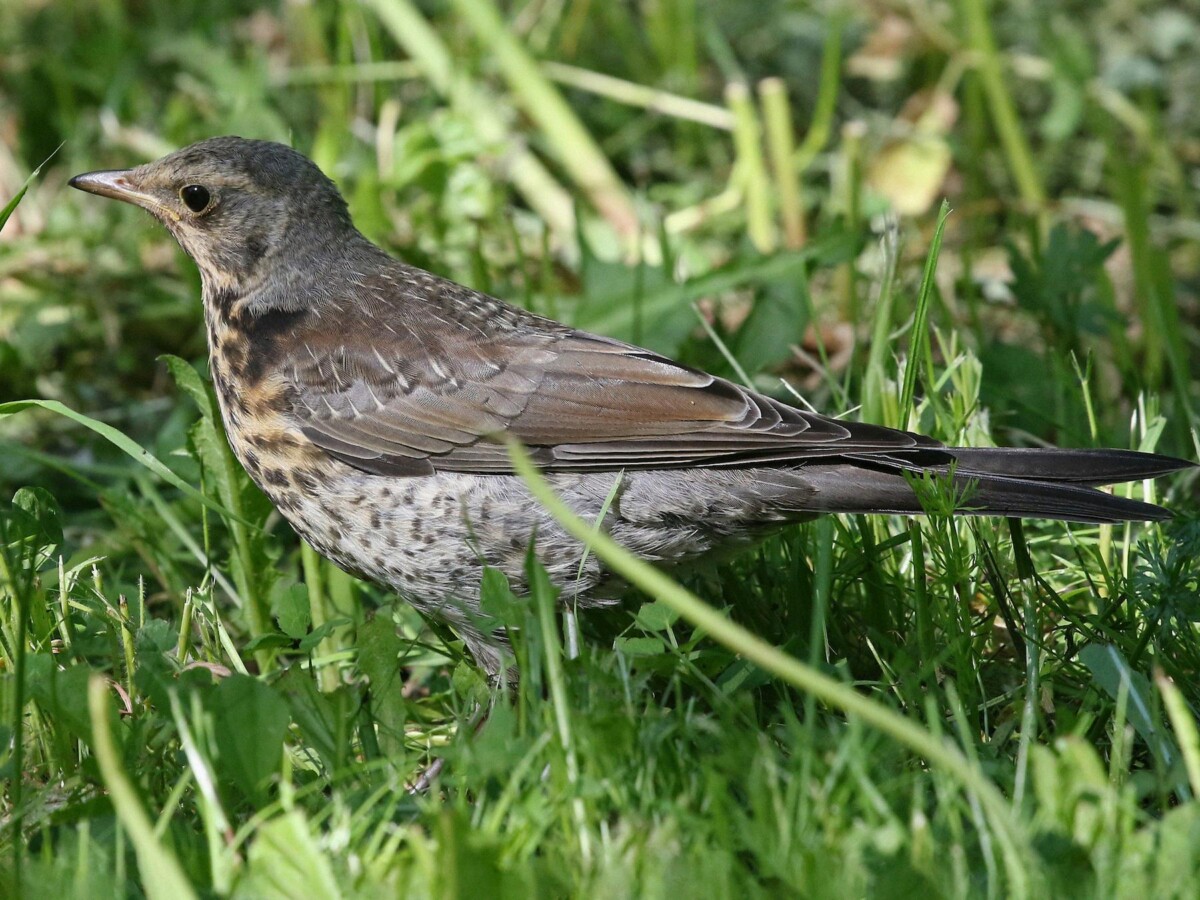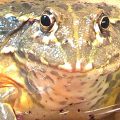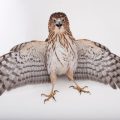The fieldfare (Turdus pilaris) is a member of the thrush family. It breeds in northern Europe and Asia, and has a reputation for being a very hardy bird. The fieldfare is a chunky bird, with a brown back, grey breast and white belly. It has a black head with a white stripe abve the eye, and orange-yellow legs. The fieldfare is about the same size as a blackbird.
The fieldfare is a winter visitor to Britain, arriving in October and staying until April. It can often be seen in flocks feeding on farmland, where it eats mainly insects and earthworms. Fieldfares will also eat berries, and can be seen in hedgerows and woods searching for food. In winter, the fieldfare often forms mixed flocks with other thrushes, such as redwings and blackbirds.

The fieldfare is not shy and will often approach humans for food. It has a loud call which sounds like ‘tink-tink-tink’. The fieldfare is one of only a few British birds which actually increase in number duing the winter months.
What Is The Difference Between A Fieldfare And Redwing?
Fieldfares are slightly larger than redwings and have a longer tail. They are also more upright in posture and move aroud on the ground by hopping.

What Is The Difference Between A Fieldfare And A Thrush?
The most obvious difference betwen a fieldfare and a thrush is size; fieldfares are larger birds, about the same size as a mistle thrush. They also have distinctly different plumage; while both birds are brown above and pale below, fieldfares have much more extensive grey on their upperparts, while thrushes tend to be more reddish-brown. Fieldfares also have a paler face with a darker mask around the eyes, while thrushes have a more uniform brown face. Finally, fieldfares often flock together in large numbers in winter, while thrushes are more often seen alone or in pairs.
What Do Fieldfare Birds Look Like?
The fieldfare is a plump bird with a chestnut-brown back and yellow breast, streaked with black. It has a black tail, dark wings and pale grey rump and head. It is slightly smaller than the similar-looking mistle thrush, but quite distinctive. The fieldfare is a member of the thrush family, and like other thrushes, it is an accomplished singer. The male fieldfare’s song is a series of loud, clear notes, oftn likened to the sound of coins dropping on a hard surface.
Is A Fieldfare Bigger Than A Thrush?
The fieldfare is a member of the thrush family and is slightly bigger than a blackbird. It has a characteristic blue-grey head with a yellow beak, brown-grey wings and a speckled breast. The fieldfare is not to be confused with the redwing.
Do Fieldfares Sing?
No, fieldfares do not sing. They are known to make a variety of sounds, including a “chack” noise, but they do not sing in the traditional sense.

Where Can You Find A Fieldfare?
Fieldfares are best looked for in the countryside, along hedges and in fields. Hawthorn hedges with berries are a favourite feeding area. In late winter grass fields, playing fields and arable fields with nearby trees and hedges are a favourite place.
What Other Bird Looks Like A Thrush?
Other birds that look like thrushes include the American Robin, the European Robin, and the Bluebird. All of these birds share some physical similarities with thrushes, including their overll size and shape, as well as their behaviour.
What Do Redwings Look Like?
The redwing is a medium-sized thrush with dark brown upperparts and white underparts. The breast is streaked with black and the flanks and underwing are orangey-red. The face has a white eyebrow stripe and dark brown cheeks.
Where Do Redwings Go In Summer?
Redwings are songbirds that are closely related to the American robin. They are migratory birds, breeding in Scandinavia and wintering in Great Britain and Ireland. In summer, they can be found in parks and gardens, often joining flocks of fieldfares.
Do Fieldfares Nest In The UK?
Fieldfares do nest in the UK, but they are very rare breeders. They are mostly found in Scotland and northern England. Breeding has been confirmed in just four 10-km squares, in the Cairngorms, Shetland, Scottish Borders and Peak District.
Where Do Redwings Come From?
The redwing is a small thrush with striking rusty-red flanks and undertail. It is the UK’s smallest true thrush. The redwing is a member of the genus Turdus, which includes other well-known birds such as the song thrush and mistle thrush.
There are two main populations of redwings: thoe that breed in Iceland and Scandinavia, and those that breed in Russia. Both populations winter in the UK, with the Icelandic birds generally staying in Scotland and Ireland, and the Russian birds spending their winters further south in England or even in Europe.
The fist redwings start to arrive in the UK in October, with numbers increasing throughout November as more birds arrive from their breeding grounds. During the autumn months, they can be found in hedges and orchards where they feed on fruit and berries.
What Berries Do Fieldfare Eat?
The fieldfare is a thrush that is native to Europe and Asia. It is a winter migrant to Britain, arriving in October and staying util April. The fieldfare is a large bird, with a black head, grey back and rusty-red breast. It has a white rump, which is conspicuous when the bird is in flight. The fieldfare feeds on a variety of fruits, including windfall apples and berries such as holly, hawthorn and dog rose.
What Do Fieldfares Eat?
Fieldfares are opportunistic feeders and their diet can vary depending on the season and what food is available to them. In the summer months, their diet consists mainly of insects, such as worms, slugs, snails and beetles. However, in the winter months when the ground is frozen or covered in snow, they will switch to eating berries and fruit. One exception to this is apples, whih they will readily eat all year round.

Is A Thrush Bigger Than A Blackbird?
The mistle thrush (Turdus viscivorus) is a species of true thrush. The mistle thrush is larger than a blackbird in size, and is much lighter in its colourings at frst glance, and almost appear grey. The adult mistle thrush has a brown back, wings and tail with pale fringes. The underparts are whitish with black spots. It has a black head with white streaks on the forehead and red eyes. The bill is yellow with a black tip. The legs and feet are also yellow. Females and young birds are similar to the males but with duller colours.
Is The Blackbird A Thrush?
Yes, the blackbird is a thrush. The blackbird is a member of the true thrush family, which includes about 90 species of birds worldwide. The blackbird is also known as the Eurasian blackbird, or simply the blackbird, in order to distinguish it from similar-looking local species found in North America. The blackbird is a relaively small bird, with males typically measuring between 16 and 18 cm in length, and females usually measuring between 14 and 16 cm. The blackbird has glossy black feathers and yellow eyes. The male Blackbird also has a yellow bill.
What Bird Has Red On Its Wings?
The red-winged blackbird (Agelaius phoeniceus) is a passerine bird of the family Icteridae found in most of North America and much of Central America. The adult male has black feathers with a red shoulder and wing patch, while the female is mostly dark brown. The red-winged blackbird is one of the most widespread and abundant birds in North America, and its cheerful “konk-la-ree” song can be heard throughout the spring and summer.
Do Chaffinches Migrate?
Chaffinches are a type of bird that partially migrate. This means that birds breeding in warmer regions are sedentary, while thoe breeding in the colder northern areas of their range winter further south.
There are two main types of migration: partial and complete. In partial migration, only some members of a species migrate, while the rest remain in their home range throughout the year. This is the case for chaffinches. The majority of chaffinches breeding in southern Europe are sedentary, meaning they do not migrate. However, those breeding in northern Europe do migrate to avoid the cold winters.
Migration is a risky strategy for animals, as it requires them to travel long distances in unfamiliar territory. This can lead to them getting lost or being killed by predators. Migration also requires a lot of energy, which can put stress on the birds’ bodies. For these reasons, many birds only migrate if they have to, in order to survive the winter.

What Bird Makes A Noise Like A Football Rattle?
The bird that makes a noise like a football rattle is the mistle thrush. The mistle thrush is a member of the thrush family and is found in Europe, Asia and Africa. The mistle thrush gets its name from the mystical mistletoe, the berries of which are one of their favourite foods. The call of the mistle thrush is a very distinctive loud rattle, like a football rattle.
Is A Mistle Thrush Rare?
No, the mistle thrush is not a rare bird in the UK. It is found almost everywhere except the highest, barest ground, and is absent from the northern and western isles of Scotland.
How Big Is A Thrush?
The average thrush is about 12 cm (4.7 in) long, thugh the largest thrush, the Great thrush, can grow up to 28 to 33 cm (11 to 13 in) long. The Great thrush is also the heaviest thrush, weighing in at 128 to 175 g (4.5 to 6.2 oz).
Are Lapwings Plovers?
Yes, lapwings are plovers. They are fairly large birds with long reddish legs and large yellow facial wattles. They inhabit virtually the whoe of Australia and are commonly found on the shores of swamps and lakes.
What Type Of Creature Is A Fieldfare?
The Fieldfare is a Eurasian thrush species. It is very similar in overall structure to the American Robin. The Fieldfare is named ater the Anglo-Saxon word “fieldware” which translates as “traveller of the fields”. They breed in central Europe and Scandanavia, eastward through Asia.
How Many Thrushes Are There In The UK?
There are six different thrushes in the United Kingdom: the blackbird, the bluebird, the brown thrush, the song thrush, the veery, and the wood thrush.
Do Fieldfares Flock?
Fieldfares often flock together, especially when migrating. In the UK, they typically arrive in October in flocks ranging from a dozen to several hundred. This makes them relatively easy to spot.
How Do Fieldfares Protect Their Nests?
Scandinavian fieldfares use a fecal defense system to protect their nests from predators. When a predatory raven is spotted, the local fieldfare community sounds an alarm, wich gives the raven some warning that a defense is mounting. The fieldfares then defecate on the raven, which discourages the predator from attacking the nest.
Are There Fieldfares In Ireland?
The Fieldfare is a large thrush whih visits Northern Ireland in winter. It is the only common member of the thrush family occurring here with a significant amount of pale grey in the plumage. Listen out for its distinctive “chuckling” call as it feeds on hedgerow berries. Although not as colourful as some of our other winter visitors, the Fieldfare is still an attractive bird and well worth looking out for.
What Do Song Thrushes Eat?
The song thrush’s diet consists largely of earthworms and snails, both of wich the bird obtains by foraging through leaf litter on the ground. In addition to these invertebrates, the song thrush also eats a variety of insects and spiders. Fruit and berries make up a significant portion of the song thrush’s diet during the winter months when other food sources are scarce.
Fieldfare Birds Defend Their Young Against A Raven | David Attenborough | BBC Studios
Conclusion
The fieldfare is a member of the thrush family, Turdidae. The adult has dark brown upperparts, paler underparts and a rusty tail. It is about 23 cm long with a wingspan of 38 cm. It is similar in appearance to the redwing but is larger, with a greyer rump and less extensive orange underwing. The fieldfare breeds in northern Europe and Asia and winters in southern Europe, Africa and South Asia. It is a gregarious bird, forming flocks in autumn and winter whih can number in the hundreds or even thousands. These birds forage on the ground for insects, earthworms and berries.
The fieldfare is an important bird in the ecosystem as it helps to control populations of invertebrates and small mammals. It is also an important source of food for predators such as foxes, stoats and weasels. The fieldfare is classified as least concern by the IUCN Red List due to its large range and stable population. However, there has been a decline in its numbers in Europe over the last few decades, largely due to changes in agriculture and land use.












